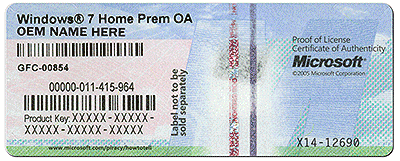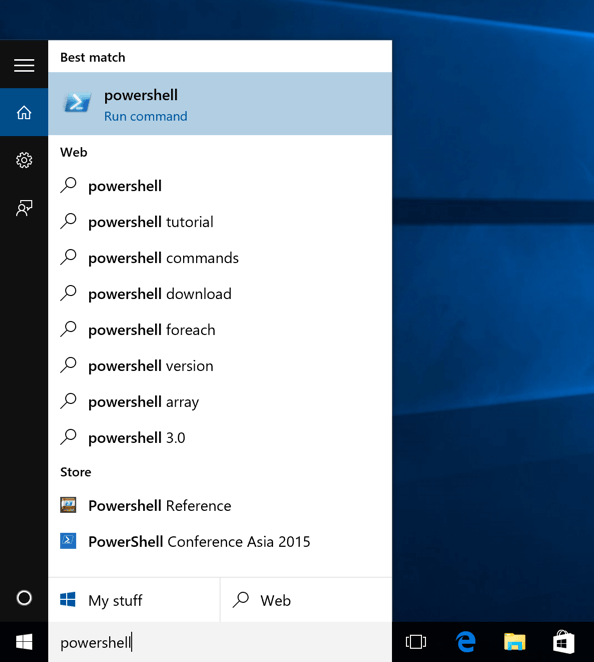
Zero Popup v4.1 serial key or number

Zero Popup v4.1 serial key or number
How to recover your Windows product key
Printed on a Certificate of Authenticity Sticker
If your PC came with Windows 7 or earlier, then your product key will be printed on a COA sticker. This sticker verifies that the computer came with a genuine copy of Windows. You will need to examine your computer to find the sticker. On laptops, it's usually on the bottom side. On desktops, it could be on the back, sides, or top. It looks something like this:
Embedded in the PC's UEFI firmware
If you have a newer PC that came with Windows 8 or Windows 10, then your product key likely won't be on a sticker. Instead, computer manufacturers now embed the key right into the computer's UEFI firmware. Unlike the COA sticker, the embedded key can't be smudged off, stolen or erased (easily).
If you want to extract the UEFI key, the process is simple. Open the Start menu, type powershell and then run the program.
Next type the following command in the PowerShell window and hit Enter.
(Get-WmiObject -query 'select * from SoftwareLicensingService').OA3xOriginalProductKeyYou will be presented with the key in the window.
Stored in the Windows Registry
If your product key isn't embedded in the firmware or you're missing your COA sticker, you're not out of luck as long as you haven't formatted your computer. You can still recover the key because Windows stores it in the registry. Here is how:
1. Open a new Notepad window
2. Copy and paste the following text into the window
Set WshShell = CreateObject("WScript.Shell") MsgBox ConvertToKey(WshShell.RegRead("HKLM\SOFTWARE\Microsoft\Windows NT\CurrentVersion\DigitalProductId")) Function ConvertToKey(Key) Const KeyOffset = 52 i = 28 Chars = "BCDFGHJKMPQRTVWXY2346789" Do Cur = 0 x = 14 Do Cur = Cur * 256 Cur = Key(x + KeyOffset) + Cur Key(x + KeyOffset) = (Cur \ 24) And 255 Cur = Cur Mod 24 x = x -1 Loop While x >= 0 i = i -1 KeyOutput = Mid(Chars, Cur + 1, 1) & KeyOutput If (((29 - i) Mod 6) = 0) And (i <> -1) Then i = i -1 KeyOutput = "-" & KeyOutput End If Loop While i >= 0 ConvertToKey = KeyOutput End Function3. Click File > Save As and save the file to your desktop as productkey.vbs. It's important to include the .vbs extension because this is a Windows Scripting Host file.
4. Close Notepad and double-click the file. Wait a few seconds, and then you will be presented with a popup displaying your product key:
AutoCAD
Solution:
Before beginning, close all Autodesk products that are running on the computer.
Make All Files Visible for Windows and macOS
Before resetting licenses, make all files visible. For Windows
To make all files visible for Windows, see Show hidden files.
For macOS
To make all files visible for macOS, do the following:
- Open a Finder window.
- Select Go > Home.
- Select View > Show View Options.
- Select Show Library Folder.
Change to "Sign in" Activation
Windows
For Autodesk software version 2020 and newer:- Open Windows command line (type cmd in Windows Search box and push Enter key).
- Run the following commands:
For Autodesk software versions 2017 to 2019:
- Using Windows Explorer, browse to the following folder:
<Version> must match the product Version (2017, 2018, etc.).
- If the folder above does not exist, create it. If it exists, open it and delete the contents.
- Open the folder and add the file LGS.data attached at the bottom of this article.
- Launch the Autodesk product again. The login window will show. Enter the Autodesk credentials and the software will launch.
- Check for the latest patch updates for the Autodesk software and make sure the Autodesk Desktop App is signed in with Autodesk ID and password.
MacOS
For Autodesk software version 2020 and newer:
- Open a terminal window (Go to Finder > Applications > Utility > Terminal).
- Run following command:
- Open Finder > Go to Folder and type /Library/Application Support/Autodesk/CLM/LGS and click Go.
- Delete the content of the folder.
- Launch the Autodesk product again. The Let's Get Started window will appear.
- Select the Sign In option (2018 version and older) or Single User option (2019 version and newer), enter the Autodesk credentials, and the software will launch.
Products:
All Desktop Products;Windows key


The Windows logo key (also known as Windows-, win-,start-, logo-, flag-, or super- key[1]) is a keyboard key which was originally introduced on the Microsoft Natural keyboard in 1994.[2] This key became a standard key on PC keyboards. In Windows tapping the key brings up the start menu. + performs the same function, in case the keyboard lacks this key.
History and usage[edit]
Historically, the addition of two Windows keys and a menu key marked the change from the 101/102-key to 104/105-key layout for PC keyboards.[3] Compared to the former layout, a Windows key was placed between the left and the left and another Windows key and the menu key were placed between the right (or ) and the right key.
The key is predated by the key on Apple computers in 1980 and the key in LISP/UNIX computers in 1970.
In laptop and other compact keyboards it is common to have just one Windows key (usually on the left). On Microsoft's Entertainment Desktop sets (designed for Windows Vista), the Windows key is in the middle of the keyboard, below all other keys (where the user's thumbs rest).
On Windows 8 tablet computers, hardware certification requirements initially mandated that the Windows key be centered on the bezel below the screen, except on a convertible laptop, where the button is allowed to be off-center in a tablet configuration. This requirement was relaxed in Windows 8.1, allowing the Windows key to be placed on any bezel or edge of the unit, though a centered location along the bottom bezel is still preferred.[4]
Licensing[edit]
Microsoft regulates the appearance of the Windows key logo picture with a specially crafted license for keyboard manufacturers ("Microsoft Windows Logo Key Logo License Agreement for Keyboard Manufacturers"). With the introduction of a new Microsoft Windows logo, first used with Windows XP, the agreement was updated to require that the new design be adopted for all keyboards manufactured after 1 September 2003.[5] However, with the release of Windows Vista, Microsoft published guidelines for a new Windows Logo key that incorporates the Windows logo recessed in a chamfered lowered circle with a contrast ratio of at least 3:1 with respect to background that the key is applied to.[6]
In Common Building Block Keyboard Specification, all CBB compliant keyboards were to comply with the Windows Vista Hardware Start Button specification beginning in 1 June 2007.[citation needed]
Wikipedia uses the Unicode character U+229E ⊞SQUARED PLUS as a simulation of the logo.
Use with Microsoft Windows[edit]
On Windows 9x and Windows NT families of Windows operating system, tapping the Windows key by itself traditionally revealed Windows Taskbar (if not visible) and opened the Start menu. In Windows Server 2012 and Windows 8, this key launches the Start screen but doesn't show the taskbar. However, this feature was added back into Windows 10.
Pressing the key in combination with other keys allows invoking many common functions through the keyboard. Holding down + will not substitute for the Windows key in these combinations. Which Windows key combinations ("shortcuts") are available and active in a given Windows session depends on many factors, such as accessibility options, the type of the session (regular or Terminal Services), the Windows version, the presence of specific software such as IntelliType and Group Policy if applicable.
Below is a list of notable shortcuts. Unless otherwise noted, they are valid in the next version of Windows.
Windows 95 and Windows NT 4.0[edit]
The following shortcuts are valid in Windows 95 and Windows NT 4.0.[7][8]
- opens the Start Menu
- + shows the desktop (hiding even non-minimizable windows), or restores hidden windows when pressed a second time.
- + opens Windows Explorer with folder pane on left side of window.
- + opens Find files and folders.
- + minimizes all windows.
- ++ restores windows that were minimized with +.
- + opens the "Run Program Or File" Window.
- + runs Utility Manager.
- + or + opens properties of My Computer.
- + opens Windows Help.
- ++ opens Find computers.
- + cycles through taskbar buttons. This key combination is reassigned in Windows Vista.
Windows 2000[edit]
Windows 2000 adds the following:
Windows XP[edit]
Windows XP adds the following:
Windows XP Media Center Edition[edit]
Windows XP Media Center Edition adds the following:
Windows Vista[edit]
Windows Vista adds the following shortcuts:
- + brings the Windows Sidebar to the front.
- + selects next Windows Sidebar gadget item, bringing all gadgets to the foreground in process. Gadgets were discontinued in Windows 8.
- + invokes Windows Mobility Center. Works only if portable computer features are installed. This key combination is reassigned in Windows 8.
- + switches active app using Aero Flip 3D. Requires desktop composition, a feature of Windows Aero. Aero Flip 3D is discontinued in Windows 8 and this key is reassigned.
- ++ is same as above, but Aero Flip 3D remains even when this key combination is released. Arrow keys or mouse may be used to navigate between windows.
- + through +, + starts the corresponding Quick Launch Bar program. + runs the tenth item. Quick Launch is discontinued in Windows 7, but later continued from Windows 8 onward.
Windows 7[edit]
Windows 7 used the following shortcuts:
- + activates Aero Peek. Reassigned in Windows 8.
- + toggles between the devices that receive video card's output. The default is computer monitor only. Other options are video projector only, both showing the same image and both showing a portion of a larger desktop.
- + maximizes the active window.
- + restores the default window size and state of the active window, if maximized. Otherwise, minimizes the active window.
- + or to align the window to the corresponding side of the screen, tiled vertically.
- ++ or to move the window to the next or previous monitor, if multiple monitors are used.
- + to iterate through items on the taskbar from left to right.
- ++ to iterate through items on the taskbar from right to left.
- + to zoom into the screen at the mouse cursor position using the Magnifier Utility.
- + to zoom out if the Magnifier Utility is running.
- + to exit zoom.
- + through +, + to either start or switch to the corresponding program pinned to taskbar. + runs the tenth item. Press multiple times to cycle through the application's open windows. Press and release quickly to keep the taskbar's preview open (which allows you to cycle using arrow keys).
- + minimizes all windows other than the active window. Pressing this combination a second time restores them.
- + minimizes all windows. Pressing the combination a second time restores them.
- + locks the computer screen.
Windows 8[edit]
Windows 8 introduces the following:
- Opens the Start Screen (Windows 8 and 8.1 only)
- + opens the charms.
- + opens Search charm in file mode to search for computer files. If the Search charm is already open, switches to file search mode.
- + opens Search charm in settings mode to search for Control Panel
What’s New in the Zero Popup v4.1 serial key or number?
Screen Shot

System Requirements for Zero Popup v4.1 serial key or number
- First, download the Zero Popup v4.1 serial key or number
-
You can download its setup from given links:





